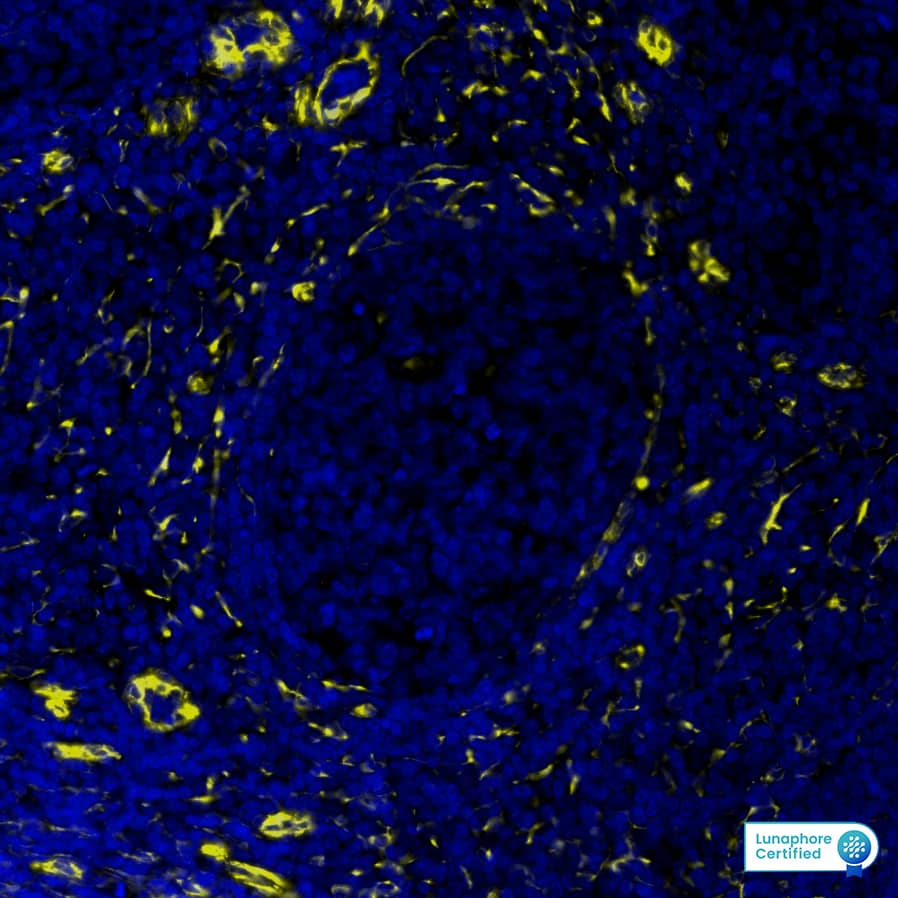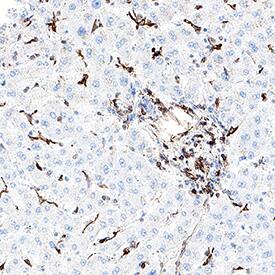Human VEGFR3/Flt-4 Antibody
R&D Systems, part of Bio-Techne | Catalog # MAB11624


Key Product Details
Species Reactivity
Applications
Label
Antibody Source
Product Specifications
Immunogen
Tyr25-Ile776
Accession # P35916
Specificity
Clonality
Host
Isotype
Scientific Data Images for Human VEGFR3/Flt-4 Antibody
Detection of VEGFR3 in Human Tonsil via seqIF™ staining on COMET™
VEGFR3 was detected in immersion fixed paraffin-embedded sections of human Tonsil using Rat Anti-Human VEGFR3, Monoclonal Antibody (Catalog #MAB11624) at 5ug/mL at 37 ° Celsius for 8 minutes. Before incubation with the primary antibody, tissue underwent an all-in-one dewaxing and antigen retrieval preprocessing using PreTreatment Module (PT Module) and Dewax and HIER Buffer H (pH 9; Epredia Catalog # TA-999-DHBH). Tissue was stained using the Alexa Fluor™ 647 Goat anti-Rat IgG Secondary Antibody at 1:200 at 37 ° Celsius for 2 minutes. (Yellow; Lunaphore Catalog # DR647RT) and counterstained with DAPI (blue; Lunaphore Catalog # DR100). Specific staining was localized to the cytoplasm and membrane. Protocol available in COMET™ Panel Builder.Detection of VEGFR3 in Human Hodgkin’s Lymphoma via seqIF™ staining on COMET™
VEGFR3 was detected in immersion fixed paraffin-embedded sections of human Hodgkin's Lymphoma using Rat Anti-Human VEGFR3, Monoclonal Antibody (Catalog #MAB11624) at 5ug/mL at 37 ° Celsius for 8 minutes. Before incubation with the primary antibody, tissue underwent an all-in-one dewaxing and antigen retrieval preprocessing using PreTreatment Module (PT Module) and Dewax and HIER Buffer H (pH 9; Epredia Catalog # TA-999-DHBH). Tissue was stained using the Alexa Fluor™ 647 Goat anti-Rat IgG Secondary Antibody at 1:200 at 37 ° Celsius for 2 minutes. (Yellow; Lunaphore Catalog # DR647RT) and counterstained with DAPI (blue; Lunaphore Catalog # DR100). Specific staining was localized to the cytoplasm and membrane. Protocol available in COMET™ Panel Builder.Detection of VEGFR3 in Human Appendix via seqIF™ staining on COMET™
VEGFR3 was detected in immersion fixed paraffin-embedded sections of human Appendix using Rat Anti-Human VEGFR3, Monoclonal Antibody (Catalog #MAB11624) at 5ug/mL at 37 ° Celsius for 8 minutes. Before incubation with the primary antibody, tissue underwent an all-in-one dewaxing and antigen retrieval preprocessing using PreTreatment Module (PT Module) and Dewax and HIER Buffer H (pH 9; Epredia Catalog # TA-999-DHBH). Tissue was stained using the Alexa Fluor™ 647 Goat anti-Rat IgG Secondary Antibody at 1:200 at 37 ° Celsius for 2 minutes. (Yellow; Lunaphore Catalog # DR647RT) and counterstained with DAPI (blue; Lunaphore Catalog # DR100). Specific staining was localized to the cytoplasm and membrane. Protocol available in COMET™ Panel Builder.Applications for Human VEGFR3/Flt-4 Antibody
Immunohistochemistry
Sample: Immersion fixed paraffin-embedded sections of human liver
Multiplex Immunofluorescence
Sample: Immersion fixed paraffin-embedded sections of human Tonsil, Hodgkin's Lymphoma, and Appendix.
Formulation, Preparation, and Storage
Purification
Reconstitution
Formulation
Shipping
Stability & Storage
- 12 months from date of receipt, -20 to -70 °C as supplied.
- 1 month, 2 to 8 °C under sterile conditions after reconstitution.
- 6 months, -20 to -70 °C under sterile conditions after reconstitution.
Background: VEGFR3/Flt-4
VEGFR2 (KDR/Flk-1), VEGFR1 (Flt-1) and VEGFR3 (Flt-4) belong to the class III subfamily of receptor tyrosine kinases (RTKs). All three receptors contain seven immunoglobulin-like repeats in their extracellular domains and kinase insert domains in their intracellular regions. The expression of VEGFR1, 2, and 3 is almost exclusively restricted to the endothelial cells. These receptors are likely to play essential roles in vasculogenesis and angiogenesis. VEGFR3 cDNA encodes a 1298 amino acid (aa) precursor with a 24 aa signal peptide. Mature VEGFR3 is composed of a 751 aa extracellular domain, a 22 aa transmembrane domain and a 482 aa cytoplasmic domain. Both VEGF-C and VEGF-D have been shown to bind and activate VEGFR3 (Flt-4). VEGFR3 is widely expressed in the early embryo but becomes restricted to lymphatic endothelia at later stages of development. It is likely that VEGFR3 may be important for lymph angiogenesis.
References
- Ferra, N. and R. Davis-Smyth (1997) Endocrine Reviews 18:4.
Long Name
Alternate Names
Gene Symbol
UniProt
Additional VEGFR3/Flt-4 Products
Product Documents for Human VEGFR3/Flt-4 Antibody
Product Specific Notices for Human VEGFR3/Flt-4 Antibody
For research use only


